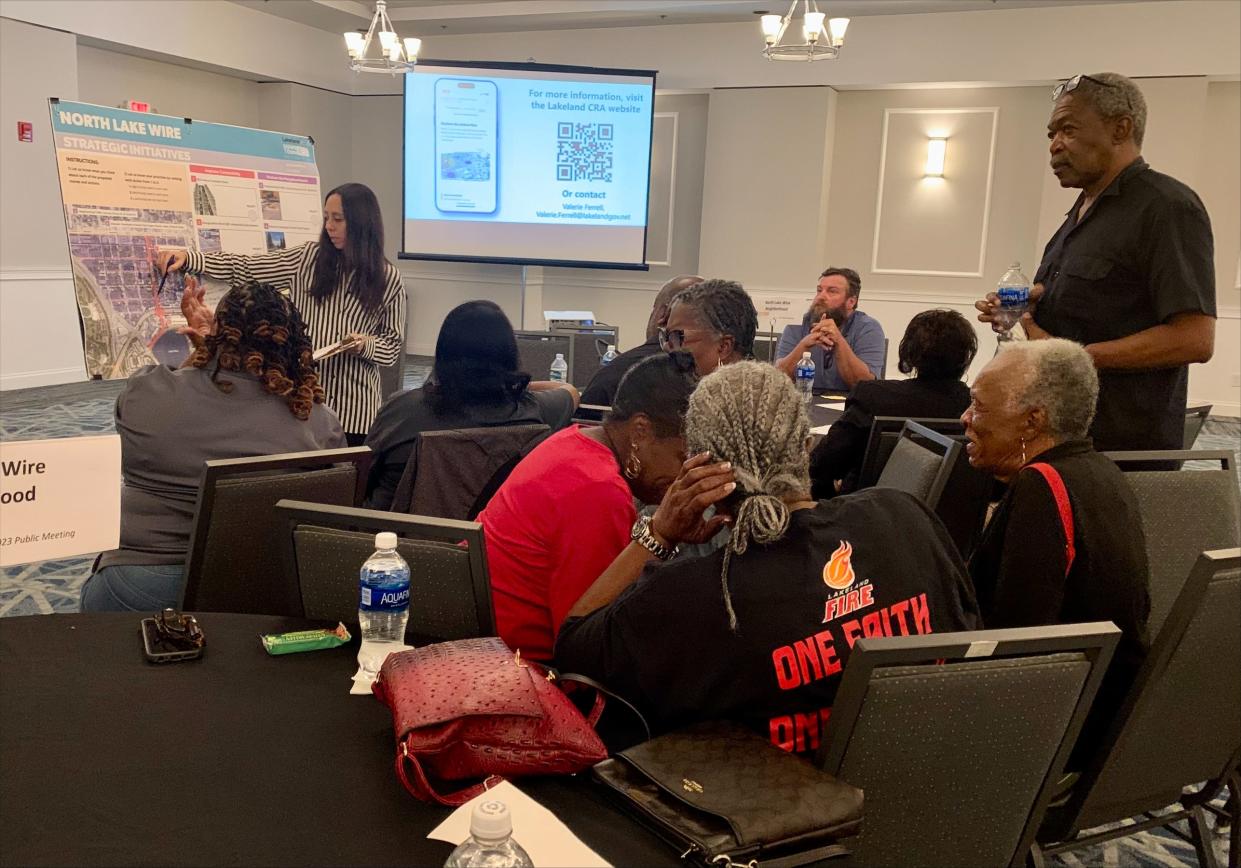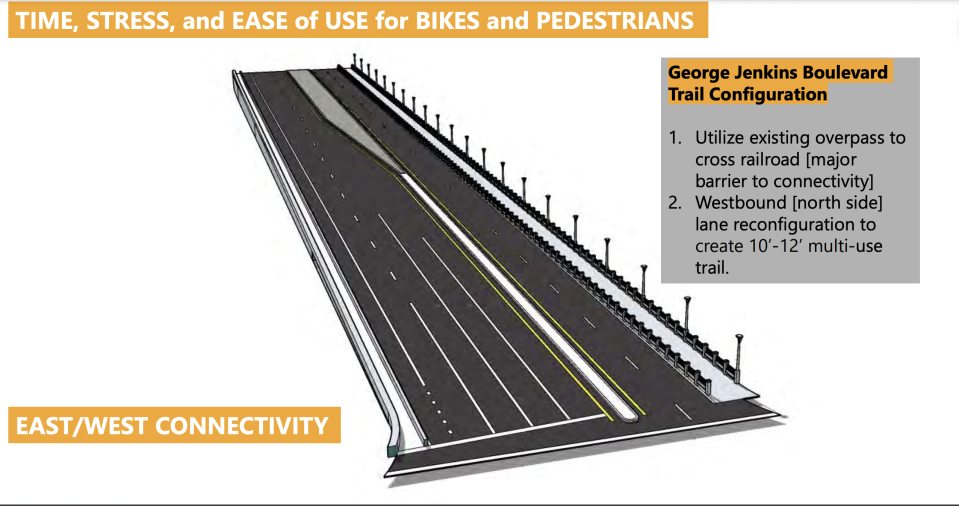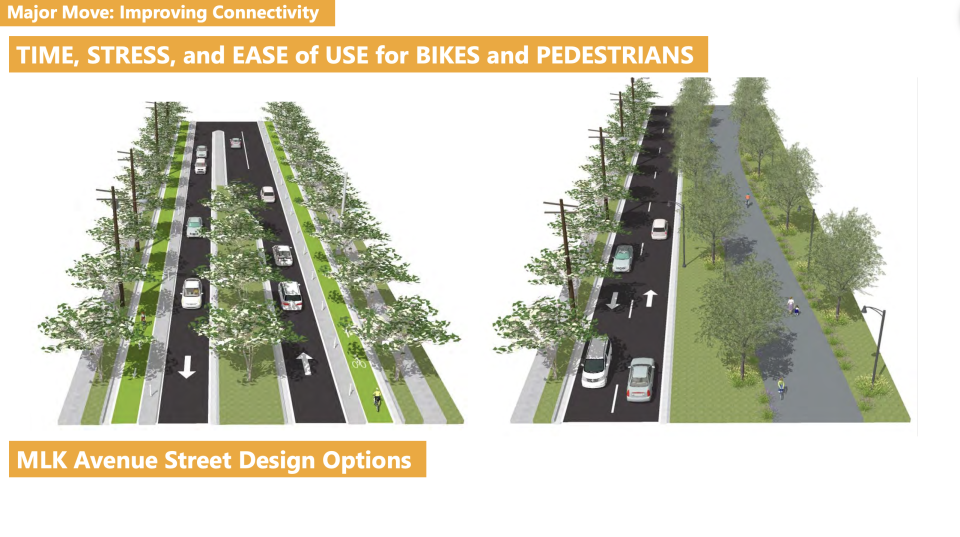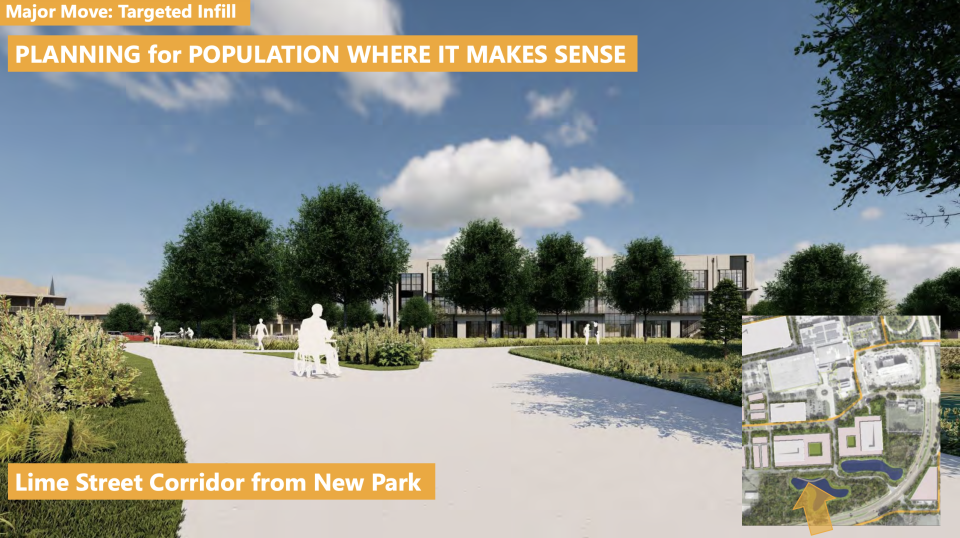Bikes and pedestrians are a major focus of public forum on Downtown West improvements

LAKELAND — More than 60 Lakeland residents gathered at the RP Funding Center on Tuesday night eager to see what major moves are being recommended for the future of Downtown West.
The city-hired GAI Consultants Inc. gave an overview of the proposed Downtown West Action Plan with a strong emphasis on rebuilding connectivity and improving the area's infrastructure to reconnect Downtown West to the city.Downtown West is an area defined as south of Memorial Boulevard, spanning from North Florida Avenue west to Brunell Parkway and south to North Ruby Street/Palmetto along the edge of Lake Hunter. It is roughly 1,140 acres.
Blake Drury of GAI Consultants recognized the broad area includes seven distinct neighborhoods ‒ North Lake Wire, Lake Wire, Crescent Heights, George Jenkins Boulevard, Downtown, Lake Beulah and Westgate-Central Avenue.
The area is close to zones the city has targeted for major redevelopment incentives, Drury said, but often has not been the direct beneficiary.
"It's truly an area that falls between the cracks," he said.
At the core of GAI Consultants' plans are transformative changes to the structure of George Jenkins Boulevard and Martin L King Jr. Avenue, two major roadways dividing and creating barriers within the community.
Lakeland resident Palm Schumacher said she appreciated focus on roads and connectivity, an area many feel is often overlooked.
"This whole emphasis on pedestrians and bikes is very refreshing for me to see," Schumacher said. "I thought it was going to be where do we put businesses, where do be put high-end homes, where do we put luxury apartments. Yes, those will come, but they are planning for how we get around."
Others said it's a good start, but raised concerns about suggested changes and the extent of the plan.
"Let's just say there's room for improvement," said Lorenzo Robinson, president of the Paul A. Diggs Neighborhood Association.
GAI Consultants presented ideas specific to each of the neighborhoods, and residents were asked to provide feedback and prioritize.

Bonnet Springs Park and George Jenkins Boulevard
A major concern previously expressed by residents is ease of access to Bonnet Springs Park, a free public park that opened in October.
The park has one main entrance off George Jenkins Boulevard, opposite Sloan Avenue. There is no easy way to cross the four-lane highway by bike or on foot.
Real estate developer David Bunch, a co-founder who envisioned Bonnet Springs Park, said Lakeland officials need to "wake up" to recognizing the park needs to be made easily accessible not only by car but pedestrians and bicyclists.
"You can't build a park like that in the middle of the city that you have to drive to," he said.
Bunch said most Lakeland's core downtown area is encircled by major highways, limiting the walkability and accessibility. There's one exception which is the Lake Morton community in the southeast quadrant of the city.
Lakeland officials need to take whatever action necessary to improve overall walkability across the city, including accessibility for pedestrians and bicyclists to Bonnet Springs Park, Bunch said. He's often heard the excuse the city doesn't have the money necessary in its budget to take on a project like a pedestrian overpass.
"The city has been gifted this enormous project that has transformed half the city," he said. "It now has a park where it used to be a rail yard. You need to connect it, if it means a big bond issue to do it — then do it."
GAI Consultants have suggested George Jenkins Boulevard could be reconfigured to allow a pedestrian overpass to be built, and the westbound lanes reduced to allow a 10-12 foot wide multiuse trail to be build north of the roadway.

North Lake Wire
One of the more dramatic changes recommended for the North Lake Wire Neighborhood by GAI Consultants is reducing Martin L King Jr. Avenue from four lanes to two, one travel lane each direction, to allow room for a pedestrian path and make it easier to cross.
"It sounds good, but It's not going to work," Robinson said. "We have traffic there now."
Jaqueline Speed said there is heavy traffic during school days on Martin L King Jr. as parents and students travel to Lincoln Avenue Academy and Rochelle School of the Arts, even if located just north of the official parameters of Downtown West.
Claudia Ray, GAI's senior planner and urban designer, said area residents were widely opposed to a four-to-two lane reduction of the roadway Tuesday night, but said they may be willing to consider going to three lanes. There is solid support for pedestrian improvements.
Robinson said he's very happy to see an effort to beautify the road and make it more accessible, but GAI's suggestions don't go far enough.
"Now that we have a park, they want to make the entrance nice," he said. "But you also make it conducive to everyone in the neighborhood."Residents expressed a desire to see the Downtown West Action Plan address conditions of North Lake Wire's residential streets on either side of Martin L. King Jr. Ave. The area's roads are in poor condition and in need of pothole repair, Robinson said, and existing sidewalks are badly damaged and cracked, obscured by low-hanging tree limbs.
There's a desire for the city to better maintain the existing roads and sidewalks. Robinson asked for residential roads used by the community's children to be wider were possible, or alternatively narrowed with a bike path, and added street lights to improve safety.
"Take the plan a step further," he said. "Do the areas on both sides of MLK."
Community leaders pushed GAI to recommend a property tax incentive program for existing owners, Ray said. This ideally would include money for homeowners to make exterior improvements, ranging from paint and fences to landscaping, or interior renovations to key plumbing and electrical systems in older houses.
Area residents are widely supportive of a suggested infill development program, but want the city to offer a program to offset any kind of increase in property values — and thus taxes — to seniors and longtime homeowners. Robinson said many longtime residents wouldn't be able to handle a significant increase in taxes as property values rise.
Residents have asked city officials to provide more widespread notification when a business seeks a change of zoning or approvals to open. Community members do not want to see more smoke shops, bars, liquor stores, 24/7 lounges or used car lots, Ray said based on feedback gather. There is a strong desire for local, non-chain restaurants and a grocery store.
Crescent Heights
GAI Consultants has found a small but actively engaged group of residents in Crescent Heights — a small community north of George Jenkins Boulevard adjacent to Bonnet Springs Park.
Residents placed a high priority on GAI's recommendations for safety and infrastructural improvements. One proposed a roundabout at Sloan Avenue and George Jenkins Boulevard, the entrance to Bonnet Springs Park, to force drivers to slow down.
Other general notes include safety improvements to George Jenkins Boulevard, where have said trying to make a left-hand turn off the roadway is difficult and dangerous. One suggestion is reducing the road from four to three lanes, one travel lane each direction with a central turn lane.
Top priority was also given to bringing sewers to the residential homes. The city's sewers were extended to Bonnet Springs Park, bringing pipelines within close proximity to many residences, but the residences remain unconnected. Many say a sewer system would further encourage development of vacant properties in the area and add value.
The consultants have also recommended this is an area where infill development could be incentivized by the city. GAI Consultants has recommended an "Arts Gateway" be built along George Jenkins Boulevard as a possible multi-story, mixed-use building where the ground level is for retail or commercial uses.

Westgate-Central Avenue and Lake Beulah
A study of the Westgate-Central Avenue and Lake Beulah neighborhoods led the consultants to strongly recommend that the city invest in sidewalk improvements to make it more pedestrian and bicyclist friendly.
Drury said the goal is not to have sidewalks on both sides of every street, but rather make sure no one has to walk more than a block to find a sidewalk and make sure the existing system is connected. This would hopefully allow residents to use the railroad underpass to make their way to George Jenkins Boulevard and ultimately, Bonnet Springs Park.
In existing industrial areas bordering the tracks, Drury said the city should consider allowing a specific industrial mixed-use concept to happen, blending light industrial uses that aren't so offensive in smells and materials with residential.
'These are beacons of light' Lakeland developer building modern homes in city's Northwest
Lake Wire
There are major residential developments approved near the Lake Wire district that could have significant impacts on the surrounding community. These projects include Peachtree Flats , adding 84 apartments at the former retirement home, and increased density on the existing parking lots of The Ledger's property, approved to add high-rise complexes containing up to 500 apartments.
With the anticipated development, Drury said GAI Consultants will recommend the city upgrade its existing pathways around Lake Wire. It currently has about a 5-foot sidewalk, Drury said, that could be expanded to 10 to 12 feet and include features such as benches and bike racks, as seen around Lake Beulah.
This trail could be connected to pathways at the RP Funding Center, Orange Street, the New York Avenue cycle path and over to Hollis Gardens. This combined pathway has been tentatively name "The Arts Loop Pathway."
GAI Consultants also said municipal-owned property near the RP Funding Center and its retaining ponds could be improved to serve as a passive parks with trails, perhaps attracting greater opportunity for development. New York Avenue also has a number of surface parking lots the study found could be redesigned with wider sidewalks to become home to multi-story, mixed-use buildings.
The full 71-slide presentation can be viewed on Lakeland CRA's website at www.lakelandcra.net/cra-feature-downtownwest
Sara-Megan Walsh can be reached at swalsh@theledger.com or 863-802-7545. Follow on Twitter @SaraWalshFl.
This article originally appeared on The Ledger: Downtown west improvement plans are heavy on bikes and pedestrians

